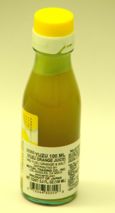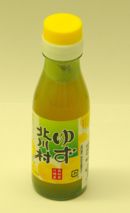Yuzu: Difference between revisions
imported>Hayford Peirce (added an omitted word) |
imported>Hayford Peirce (cake, not cafe. Maybe it's served at Yoko's Westside Yuzu Cafe as a coffee cake?) |
||
| Line 5: | Line 5: | ||
The '''Yuzu''' is a little-known member of the [[citrus]] family that originated in [[China]] but that is used most frequently in [[Japan]], where an ornamental version is also grown for its flowers. ''The New York Times'' has said that it has a "distinctive flavor and aroma, a complex blend of lime, lemon and grapefruit."<ref>"The Secrets Behind Many Chef's Not-So-Secret Ingredient", by David Karp, ''The New York Times'', December 3, 2003, at [http://www.nytimes.com/2003/12/03/dining/03YUZU.html?ex=1385787600&en=503d5cd5111f4124&ei=5007&partner=USERLAND]</ref> It is, apparently, a hybrid of two other citrus varieties, the [[Ichang papeda]] (''Citrus ichangensis'') and the [[sour mandarin orange]] (''C. reticulata''), although it was formerly classified as its own species, ''C. junos''.<ref>''The Oxford Companion to Food,'' ed. Alan Davidson (Oxford: Oxford University Press, 1999), s.v. Yuzu.</ref> Its size varies, from that of a [[lemon]] to that of a [[grapefruit]], and its skin color can be yellow, orange, or green. It is tart in flavor and is seldom eaten by itself, being used instead in various flavorings. Given its somewhat murky origins, its name is also ambiguous—references can be found in English for both the '''Yuzu lemon''' and the '''Yuzu orange'''. | The '''Yuzu''' is a little-known member of the [[citrus]] family that originated in [[China]] but that is used most frequently in [[Japan]], where an ornamental version is also grown for its flowers. ''The New York Times'' has said that it has a "distinctive flavor and aroma, a complex blend of lime, lemon and grapefruit."<ref>"The Secrets Behind Many Chef's Not-So-Secret Ingredient", by David Karp, ''The New York Times'', December 3, 2003, at [http://www.nytimes.com/2003/12/03/dining/03YUZU.html?ex=1385787600&en=503d5cd5111f4124&ei=5007&partner=USERLAND]</ref> It is, apparently, a hybrid of two other citrus varieties, the [[Ichang papeda]] (''Citrus ichangensis'') and the [[sour mandarin orange]] (''C. reticulata''), although it was formerly classified as its own species, ''C. junos''.<ref>''The Oxford Companion to Food,'' ed. Alan Davidson (Oxford: Oxford University Press, 1999), s.v. Yuzu.</ref> Its size varies, from that of a [[lemon]] to that of a [[grapefruit]], and its skin color can be yellow, orange, or green. It is tart in flavor and is seldom eaten by itself, being used instead in various flavorings. Given its somewhat murky origins, its name is also ambiguous—references can be found in English for both the '''Yuzu lemon''' and the '''Yuzu orange'''. | ||
Japan and Korea both make use of the yuzu in cooking, but to a greater degree in Japan than elsewhere. There its juice is bottled commercially and a yuzu vinegar is also produced, as well as liqueurs and wines. Chefs in [[New York City]] in the early days of the 21st century discovered the yuzu, and such celebrity restaurants as [[Jean George]] have begun using it in creative ways. <ref>Karp, op. cit.</ref> Fresh yuzus cannot be legally imported into the United States but small quantities of them have been grown and sold locally since the late 19th century. Because of their scarcity, their price is relatively high. As late as 1995, in the second edition of the ''Food Lover's Companion'', it was stated that yuzus were used "almost exclusively for its aromatic rind."<ref>''The New Food Lover's Companion,'' Second Edition, by Sharon Tyler Herbst, Barron's, Hauppauge, New York, 1995, ISBN 0-8120-1520-7</ref> In recent years many references to yuzus have been made by ''New York Times'' articles about restaurants, pastry shops, bars, and home cooking. The ''New York Times Magazine'' for Sunday, February 3, 2011, for instance, had a recipe for Yuzu Chiffon | Japan and Korea both make use of the yuzu in cooking, but to a greater degree in Japan than elsewhere. There its juice is bottled commercially and a yuzu vinegar is also produced, as well as liqueurs and wines. Chefs in [[New York City]] in the early days of the 21st century discovered the yuzu, and such celebrity restaurants as [[Jean George]] have begun using it in creative ways. <ref>Karp, op. cit.</ref> Fresh yuzus cannot be legally imported into the United States but small quantities of them have been grown and sold locally since the late 19th century. Because of their scarcity, their price is relatively high. As late as 1995, in the second edition of the ''Food Lover's Companion'', it was stated that yuzus were used "almost exclusively for its aromatic rind."<ref>''The New Food Lover's Companion,'' Second Edition, by Sharon Tyler Herbst, Barron's, Hauppauge, New York, 1995, ISBN 0-8120-1520-7</ref> In recent years many references to yuzus have been made by ''New York Times'' articles about restaurants, pastry shops, bars, and home cooking. The ''New York Times Magazine'' for Sunday, February 3, 2011, for instance, had a recipe for Yuzu Chiffon Cake. <ref>The recipe can be found at [http://www.nytimes.com/2011/02/13/magazine/13Food-t-002.html?sq=oliver%20strand%20yuzu&st=cse&adxnnl=1&scp=1&adxnnlx=1300406425-a/zG+pXJtUcLTK3d8o3dGQ]</ref> | ||
{{Image|Yuzu Chiffon Cake 2.jpg|left|135px|A yuzu chiffon cake made from a ''New York Times'' recipe}} | {{Image|Yuzu Chiffon Cake 2.jpg|left|135px|A yuzu chiffon cake made from a ''New York Times'' recipe}} | ||
Revision as of 19:45, 17 March 2011
The Yuzu is a little-known member of the citrus family that originated in China but that is used most frequently in Japan, where an ornamental version is also grown for its flowers. The New York Times has said that it has a "distinctive flavor and aroma, a complex blend of lime, lemon and grapefruit."[1] It is, apparently, a hybrid of two other citrus varieties, the Ichang papeda (Citrus ichangensis) and the sour mandarin orange (C. reticulata), although it was formerly classified as its own species, C. junos.[2] Its size varies, from that of a lemon to that of a grapefruit, and its skin color can be yellow, orange, or green. It is tart in flavor and is seldom eaten by itself, being used instead in various flavorings. Given its somewhat murky origins, its name is also ambiguous—references can be found in English for both the Yuzu lemon and the Yuzu orange.
Japan and Korea both make use of the yuzu in cooking, but to a greater degree in Japan than elsewhere. There its juice is bottled commercially and a yuzu vinegar is also produced, as well as liqueurs and wines. Chefs in New York City in the early days of the 21st century discovered the yuzu, and such celebrity restaurants as Jean George have begun using it in creative ways. [3] Fresh yuzus cannot be legally imported into the United States but small quantities of them have been grown and sold locally since the late 19th century. Because of their scarcity, their price is relatively high. As late as 1995, in the second edition of the Food Lover's Companion, it was stated that yuzus were used "almost exclusively for its aromatic rind."[4] In recent years many references to yuzus have been made by New York Times articles about restaurants, pastry shops, bars, and home cooking. The New York Times Magazine for Sunday, February 3, 2011, for instance, had a recipe for Yuzu Chiffon Cake. [5]
Taking a yuzu-yu (yuzu bath), a hot bath in which whole yuzu fruit are floated, is a winter solstice tradition in Japan; the fruit, which ripens in late autumn, is associated with winter in Japanese culture.[6] It is, perhaps not coincidentally, one of the very few citrus tress that can survive freezing weather, withstanding regular winter temperatures as low as 15 degrees Fahrenheit (-7 degrees Celsius).
References
- ↑ "The Secrets Behind Many Chef's Not-So-Secret Ingredient", by David Karp, The New York Times, December 3, 2003, at [1]
- ↑ The Oxford Companion to Food, ed. Alan Davidson (Oxford: Oxford University Press, 1999), s.v. Yuzu.
- ↑ Karp, op. cit.
- ↑ The New Food Lover's Companion, Second Edition, by Sharon Tyler Herbst, Barron's, Hauppauge, New York, 1995, ISBN 0-8120-1520-7
- ↑ The recipe can be found at [2]
- ↑ Davidson, op. cit.


